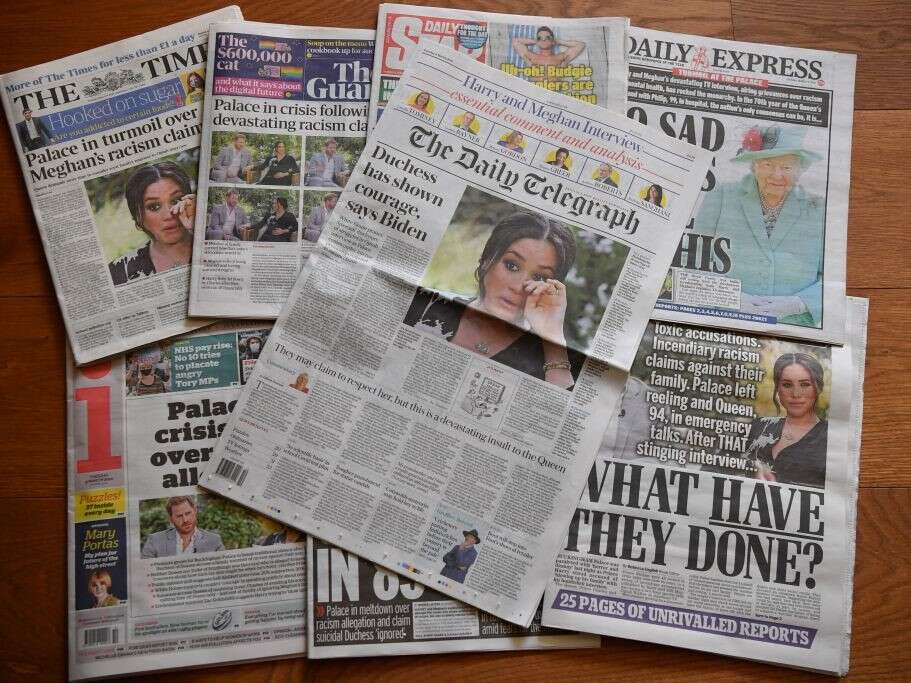
Prince Harry’s assertion that the UK tabloid press is bigoted and racist forced the resignation of Society of Editors executive director Ian Murray earlier this month when he issued a blanket denial of the bigotry claim.
And Oprah Winfrey claimed Meghan Markle was subject to racist coverage from the UK press in her interview with the royal couple, backing up the claim with a misleadingly edited montage of headlines.
Here freelance journalist and media commentator Liz Gerard, a former night editor of The Times, takes a deep look at press coverage in recent years and gives her view on the question of whether Fleet Street is bigoted and on whether Meghan coverage was racist?
Bigot: 1: A hypocrite; 2: A person obstinately and unreasonably wedded to a creed, opinion or ritual (OED)
The Times newsroom in 1981 was not exactly a multicultural environment. There was an Indian boxing correspondent and an Indian down table sub. The writer was widely respected; the sub was chained to the lowest rung of the journalistic ladder. This was an injustice. He was far and away the fastest sub on the desk and among the most diligent in raising valid queries – which were not always welcome.
On Saturday shifts at the Sunday Times, he was recognised as a capable copytaster, but promotion was out of the question in the day job. The paper’s all-white, all-male executives couldn’t understand a word he said and were not about to take the time and trouble to listen properly. A couple made no bones about the roots of their ambivalence.
Indeed, they were terrifyingly open about their attitude to anyone with a dark skin – in the office, in print or in life. If I made an error in my subbing, an excuse was offered up for me and all was soon forgotten; if my Indian friend slipped up, he was carpeted and threatened with verbal and written warnings.
He never complained or ceased working his backside off – and eventually approached a series of executives asking if he could write on race issues for the paper. He was rebuffed and told that no such role was required because The Times was “colour blind”.
Was it? In the 1980s it maintained an inexplicable attachment to Enoch Powell and a Friday ritual was to leave a front-page slot open if the Great Man was due to speak. Which he did often.
Come the 1990s, there was a flurry of stories about immigrants bringing in HIV, TB and other undesirable diseases. But was it generally racist? Not that I recall.
Which is more than could be said for another national newspaper which I have chosen not to name.
A former colleague who did shifts on the newsdesk there in the 1990s recalls that there was a blacklist of people about whom the paper would not run stories, no matter how good the tale. Top of this list were foreigners and “lowlifes” – who included “anyone with a non-English name, Irish and the entire working class, unless a yuppie plumber”. There were no page leads about black people because page leads had to have an accompanying photograph and “photographers couldn’t take pictures of black people because you couldn’t see their features”.
Meanwhile, over at The Sun (and the News of the World) there was a dread of “poofs” and “queers”, from the “gay plague” and “despicable” gay kiss in “EastBenders” of the 1980s to the “gay mafia” running the country in the late 1990s – when it demanded that all homosexual MPs be outed, explaining: “Their sexuality is not the problem. The worry is their membership of a closed world of men with a mutual self-interest.”
The Sun’s unnecessary and unpalatable attack on Benjamin Zephaniah in 1987
This from a newspaper whose foreign owner has spent decades wielding behind-the-scenes power in private meetings with successive prime ministers.
These were the sort of environments and attitudes that bred the worst of the headlines and the worst of the incidents that are still being cited as evidence of institutional bigotry.
Read more:
- Two in five journalists responding to our survey say they have seen or experienced racism working in the UK media
- Two-thirds of journalists responding to our survey say UK media is bigoted or racist in some way
- Meghan coverage was racist according to half journalists filling out Press Gazette survey
- Comment: Prince Harry has highlighted an issue for the news industry which needs to be addressed
‘Is that all you’ve got?’
But the repeated sharing on social media of The Sun’s unnecessary and unpalatable attack on Benjamin Zephaniah in 1987 (pictured above) and cuttings showing the Daily Mail’s brief flirtation with the Nazi Party in the 1930s don’t help the argument that the press is prejudiced now.
Rather, they beg the question “Is that all you’ve got? Perhaps focus on the present century?” Well it isn’t.
It’s fair to say that we’ve come a long way over the intervening years, and the pace of change is quickening. But the complacency and arrogance is shocking. And it was those twin vices that were the undoing of the Society of Editors’ well-intentioned Ian Murray (more of him later). By far the greater part of the journey still lies ahead – and accelerating from sloth’s to snail’s pace won’t do.
There is a nastiness within some papers that will not go away, a hostility to people perceived as threats to the interests of their readers (or, as some would say, to the interests of their proprietors). We have seen this “othering” over recent decades with the vilification of “welfare scroungers”, homosexuals, immigrants, travellers, Muslims, transgender people. The defence is always that it is the press’s job to tackle issues that matter to readers, but to pretend there is no prejudice is wilful blindness. The xenophobia – albeit much of it encouraged by our politicians – is breathtaking.
Many white journalists working today – unlike ancient armchair observers like myself – insist that their papers aren’t racist and that there is no bigotry in their newsrooms. They and their colleagues say they are all normal people getting on with their lives with no side.
Older women among them can be particularly robust, often mentioning sexism they put up with years ago, as though it’s a fact of life that everyone who isn’t a straight white male has to tolerate offensive behaviour of some kind; that people should accept that and get over themselves. Meghan is just whingeing and self-obsessed, they say.
Those older straight white men meanwhile bemoan woke snowflakery. But black, brown, gay and trans journalists tell a different story.
The big question is not whether individuals are racist or bigots – there must surely be far fewer of these today than there were 30 or 40 years ago – but whether their publications are.
A recurring theme in responses to that question was that, while there was very little evidence of racism among journalists and editors in person, pandering to the (many) prejudices of readers was commonplace as a means of selling newspapers.
‘Like promotes like’
One tabloid columnist noted that the real inequality had nothing to do with race, religion, gender or sexual orientation, but was between the private and state-educated, between the officer class and the ground troops: “Like promotes like and there’s very little diversity.”
Therein lies the problem. A Women in Journalism survey last year found that in one July week no non-white journalist had a front-page byline in any of our national newspapers, while only one black person was quoted in any page-one story – and this was just after the BLM protests.
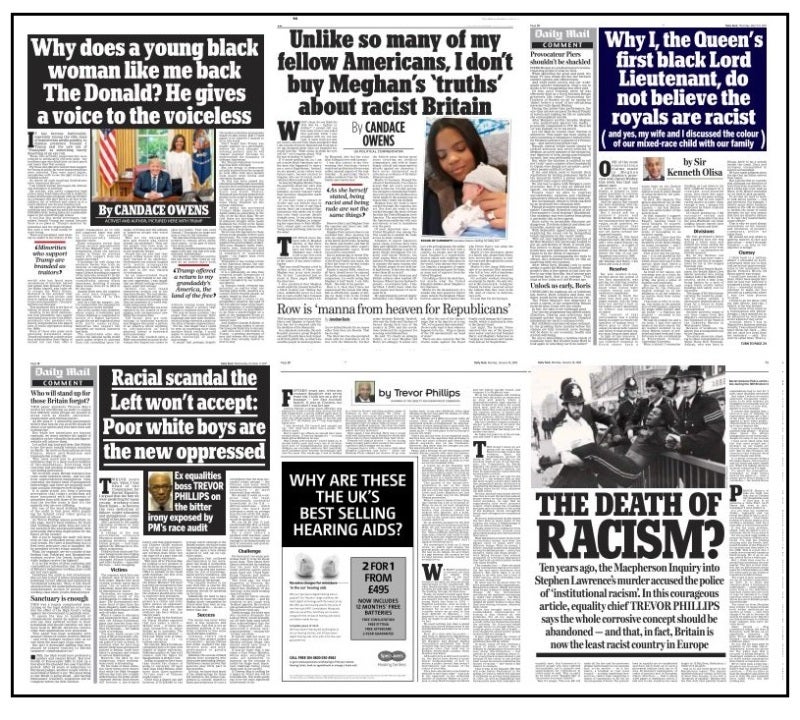
‘Everything’s all right, nothing to see here, who are you calling racist?’
By my tally 130 columnists have a fixed slot in our national dailies’ main comment sections; all but nine are white.
The Mirror has Eva Simpson, Darren Lewis and Nada Fahoud, The Guardian Nesrine Malik, Aditya Chakrabortty and Afua Hirsch, the i Yasmin Alibhai Brown and Stephen Bush and the Telegraph Sherelle Jacobs. Another half a dozen or so make fairly regular appearances and a few more – like Baz Bamigboye on showbiz in the Daily Mail and Matthew Syed on sport in The Times – have a specialist slot. But there is a marked dearth of people of colour being allowed a say on life in general.
Rather, writers of colour are frequently brought in because of their colour and only to opine on the latest race issue – often to perpetuate the “everything’s all right, nothing to see here, who are you calling racist?” line of attack-dog defence. As with this from the Mail in the aftermath of the Oprah interview: “Why I, as the Queen’s first black Lord Lieutenant, do not believe the royals are racist”.
As executive director of the Society of Editors, Ian Murray thought he was making progress in encouraging diversity in the Press Awards and by securing black ITV presenter Charlene White to host this year’s event. But then he blundered in his response to Prince Harry’s bigotry allegation and in one statement and one heated television interview with the BBC’s Victoria Derbyshire undid all his good work.
More than 200 journalists of colour signed an open letter protesting at the statement, which the i’s Oly Duff denounced as ludicrous. White pulled out of the awards, as did a number of entrants, including some from Buzzfeed, the Mirror and the Yorkshire Post.
Murray has fallen on his sword, and the Society has postponed its awards. But its refusal so far to withdraw Murray’s statement that the UK media is not bigoted prompted board member Eleanor Mills to resign on Friday.
‘Does anyone think we could have sold all those copies with a racist agenda?’
Few have stood up to defend Murray, possibly fearing that to do so would mean sharing his fate, but one former tabloid executive speaking off the record said: “At ground level, on the subs’ table and backbenches, I saw mostly decent people, fair-minded, with no hidden agendas. At senior level I saw ranting, raving big personalities under huge pressure, various crackpot obsessions, but none motivated by a desire to persecute anyone without a white skin.
“The idea that we sat around in conference planning how we could be racist and bigoted is rubbish. Just consider the commercial realities. We sold big in factories and other workplaces where non-whites were in the majority. Many of our biggest names were black sports stars. Does anyone really think we could have sold all those copies and had so many black star columnists if there had been a racist agenda?”
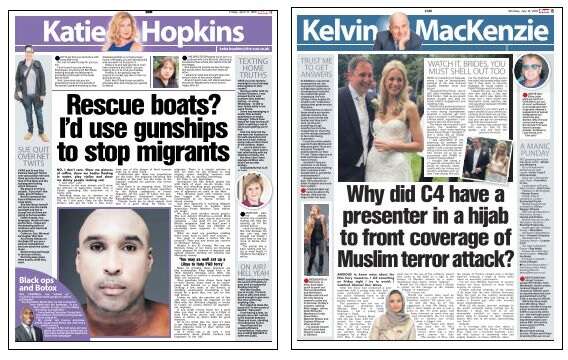
Complaints about Katie Hopkins describing immigrants as ‘cockroaches’ and Kelvin MacKenzie criticising Channel 4 for having a woman in a hijab read the news about the Nice terror attack were rejected
But did Prince Harry accuse anyone of having a racist agenda? You don’t have to set out to be racist to be so. All you need to fall into elephant traps is to be blinkered.
Just think of Grandad trying desperately to think of the “PC” way of saying something that might not have raised an eyebrow half a century ago: he is so anxious to get the wording right that he doesn’t realise it’s the sentiment he’s trying to express that is problematic.
Of course, there are no conference discussions about a persecution agenda. It doesn’t work that way. The day-to-day newslists and hence the general tone of the paper is set almost by osmosis: desk executives just know what will get into print.
A curled lip from the editor in response to a pitch is likely to deter the newsdesk from offering stories on similar subjects in the future, whereas a spark of interest from the chair will inspire further digging in that particular mine. The message gets passed down the food chain, so that reporters realise that there is an appetite for a certain sort of story, news agencies recognise there is a market and, bob’s your uncle, they’re everywhere – whether it’s dogs biting babies or uninsured drivers deliberately causing car crashes.
The industry remains in denial
The danger comes when you start wounding innocent bystanders in pursuit of what might be a perfectly legitimate campaign objective. Which is what we saw with immigration in the EU referendum campaign. It was enough to prompt the UN and the UNHCR to call for restraint, while Leicester, Cambridge and Cardiff were among the universities to produce research showing bias and hostility.
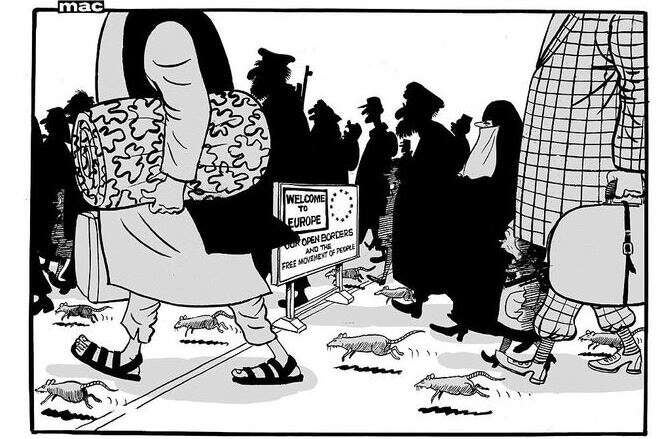
Mac cartoon in the Daily Mail from 2015
But still the industry remains in denial – does it really see no problem with a cartoon depicting Syrian refugees as rats? – bolstered by a regulator that rejected complaints about a Katie Hopkins Sun column which described immigrants as “cockroaches” because no identifiable individual could be said to have suffered discrimination and which upheld Kelvin MacKenzie’s right to criticise Channel 4 for having a woman in a hijab read the news about the Nice terror attack.
Yes, the Sun got rid of Hopkins after cockroaches and MacKenzie after he likened a footballer to a gorilla. But Richard Littlejohn didn’t break step when the transgender teacher Lucy Meadows killed herself shortly after he wrote a story headlined: “He’s not only in the wrong body…he’s in the wrong job.” Littlejohn was criticised by the coroner, although her suicide note did not mention press coverage.
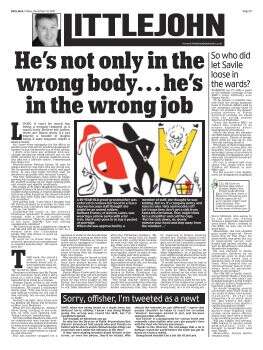
Richard Littlejohn didn’t break step when the transgender teacher Lucy Meadows killed herself a few days after he wrote this story
When a storm breaks, it’s trial by public outcry. If enough people make enough noise – as with Hopkins and MacKenzie – they’ll be quietly dropped. But it’s always the “freedom of speech” argument that’s deployed before that happens, never: “We got it wrong”.
Wave of anti-immigrant stories
Towards the end of 2013, I noticed what seemed to be a wave of anti-migrant stories as the day approached when Romanians and Bulgarians would be entitled to greater freedom of movement to the UK. They were portrayed as beggars and thieves. Buses, flights and ferries for the turn of the year were reported to be fully booked – they weren’t. There was no surge. There were no riots.
There were, however, even more stories throughout 2014 and 2015 as wars in Syria and Somalia prompted tens of thousands of people to leave their homelands and head for Europe.
As the Brexit-supporting papers, most especially the white-top tabloids, escalated their coverage to what felt like an alarming degree, I started to log “foreigner” splashes, positive or negative, and compile what I labelled the “chart of shame”.
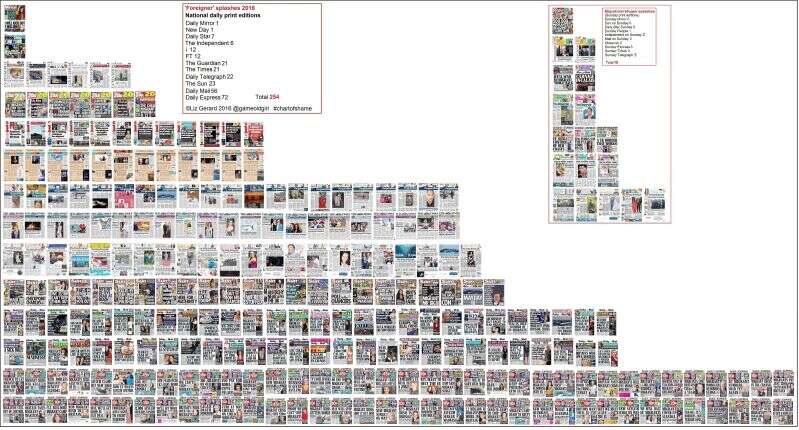
If you look at some of those headlines, particularly from the Express, you can see why. Current editor Gary Jones (who came in after Express Newspapers was bought by Reach in 2018) said they gave him sleepless nights.
In 2016 the Mail and Express ran 128 front pages and 1,768 inside pages of almost entirely negative coverage about “foreigners”– before dramatically moving away from the subject once the “Leave” result had been secured.
Immigration is a key concern of many voters and obviously a legitimate subject for newspapers, but the tone of the coverage left a nasty taste. There was little or no balance and some of it was blatantly wrong.
Did anyone seriously think 79 million Turks were going to move to Europe? Or that 12 million of them would come to live here?
Statistics about migrants “taking all new jobs”, which had been misinterpreted for years, were repeatedly misreported – even after successive IPSO rulings confirming that it just wasn’t so.
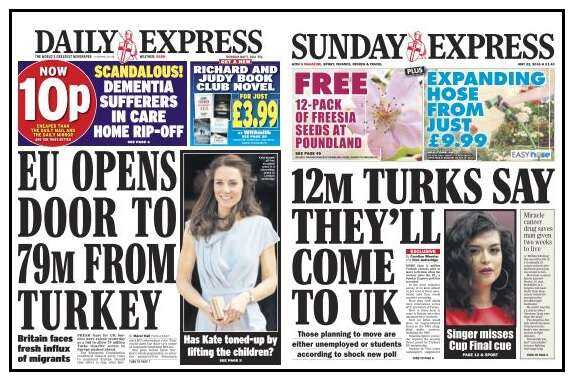
Did anyone seriously think 79 million Turks were going to move to Europe?
Official reports showing the economic and social benefits of migration – most especially the nugget that immigrants from the EU contributed more to the economy than those from the Commonwealth and elsewhere, and far more than native Brits – were given little prominence.
The ‘chart of shame’
A while later, I attended a meeting with the IPSO chairman Sir Alan Moses called by Citizens UK, a charity that helps refugees and asylum seekers settle into their new lives in Britain. I was asked to sit opposite Sir Alan, with the “chart of shame” (it was turned into an installation in a different format for the Migration Museum) on the table between us. His reaction amazed me: IPSO could not do anything about this, he said, but the police could and possibly should, because some of the headlines could be seen as breaking the law on incitement to racial hatred.
But IPSO could have done something. Even without a formal complaint, it has the power to launch its own investigations into issues of concern, and Sir Alan was willing to do that – if Citizens UK provided a volume of evidence that it was unlikely to be able to pull together. It never happened.
In the meantime, Miqdaad Versi, director of media monitoring for the Muslim Council of Britain, was busy filing individual complaints, day after day, week after week, over discriminatory coverage of Muslims.
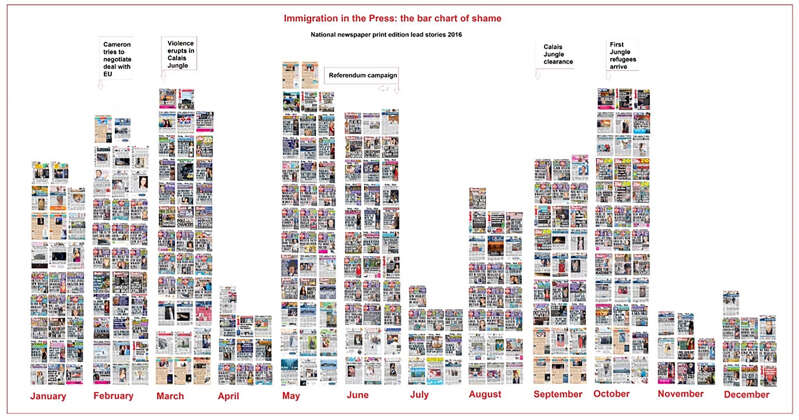
Press coverage of immigration issues realised in the ‘chart of shame’
He’s had plenty to keep him busy. Muslim affronts to “British” society have been boundless. We’ve had Muslim-only swimming pools, Muslim-only kitchen utensils, Muslim-only loos and Muslim-only curry treats; not to mention outrage over Trojan Horse schools, halal school dinners, non-halal plastic banknotes and a refusal to use anti-bacterial soap in hospitals.
But the serious damage is done with the “serious” journalism. The surveys that “find” high levels of support for terrorists among ordinary Muslims and worrying levels of ignorance of the “British” way of life.
In November 2015, ten days after the terror attacks that killed 130 in Paris, The Sun led on a survey it had commissioned, claiming that 1 in 5 Muslims had sympathy with jihadis. Four months later, IPSO upheld a complaint about the way the data were interpreted.
It was not the first time the paper had over-interpreted the results of such a survey. The previous February, a page 2 lead headline stated “1 in 4 Muslims: Hebdo justified”. The source was a BBC poll that found that one in four felt sympathy with the motives for the attack.
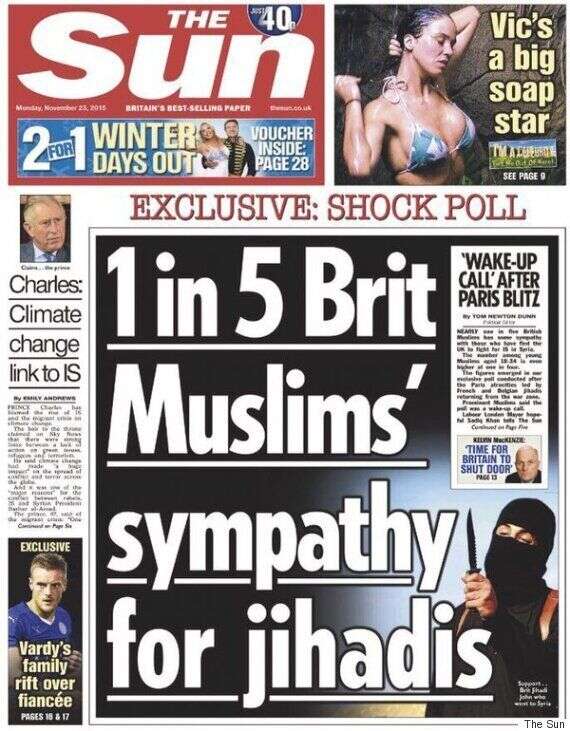
There is a world of difference between understanding why someone is upset about something and endorsing an extreme response, but that didn’t stop columnist MacKenzie extrapolating that into 800,000 people were “backing” the Paris attacks, starting with the (misquoted) declaration: “Not all Muslims are terrorists, but all terrorists are Muslims”.
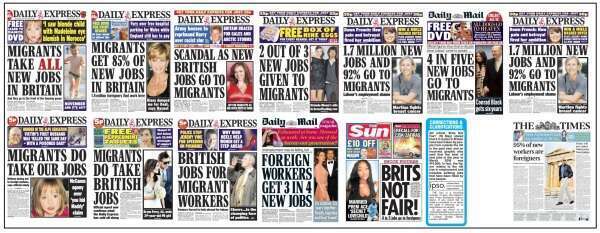
Statistics about migrants “taking all new jobs”, which had been misinterpreted for years, were repeatedly misreported – even after successive Ipso rulings confirming that it just wasn’t so
Meanwhile Trevor Kavanagh, then an IPSO board member, wrote about “The Muslim Problem” – with capital letters – and then expressed surprise that anyone should see any similarity to what the Nazis called “The Jewish Problem”.
The press, starting with big chief Rupert Murdoch, has done a lot of calling for law-abiding Muslims to rein in violent people they don’t know but who happen to share their faith.
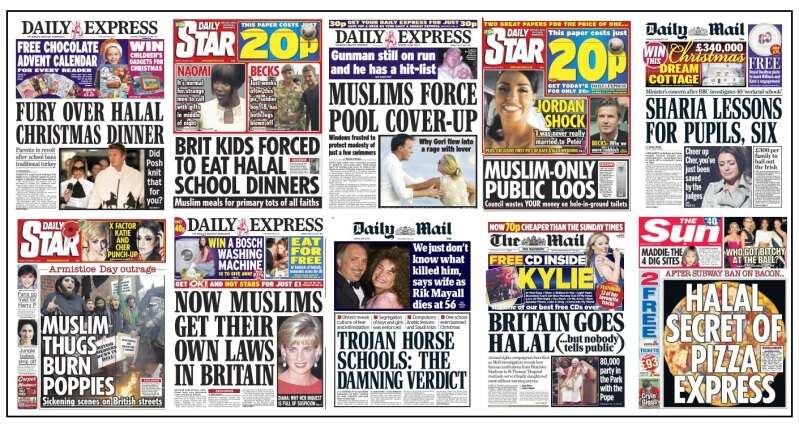
Muslim affronts to ‘British’ society have been boundless, according to many newspapers
Newspapers and Conservative politicians shout loudly and rightly about anti-semitism, yet refuse to contemplate that there is a twin problem of Islamaphobia.
There are positive stories about Muslims, but the majority – and Versi has logged thousands – appear to focus on isolation, terrorism, oppression and abuse. Time and again one wonders what writer or reader would think if the words “black”, “English”, “Catholic” or “Jew” were substituted for the word “Muslim” in a headline.
Take this splash from The Times in August 2017: “Christian child forced into Muslim foster care”. Look at the pejorative verb “forced” to describe a child being taken in by another family in an emergency. Imagine the roles reversed. Would “Muslim child taken into Christian foster care” make a story, let alone the lead?
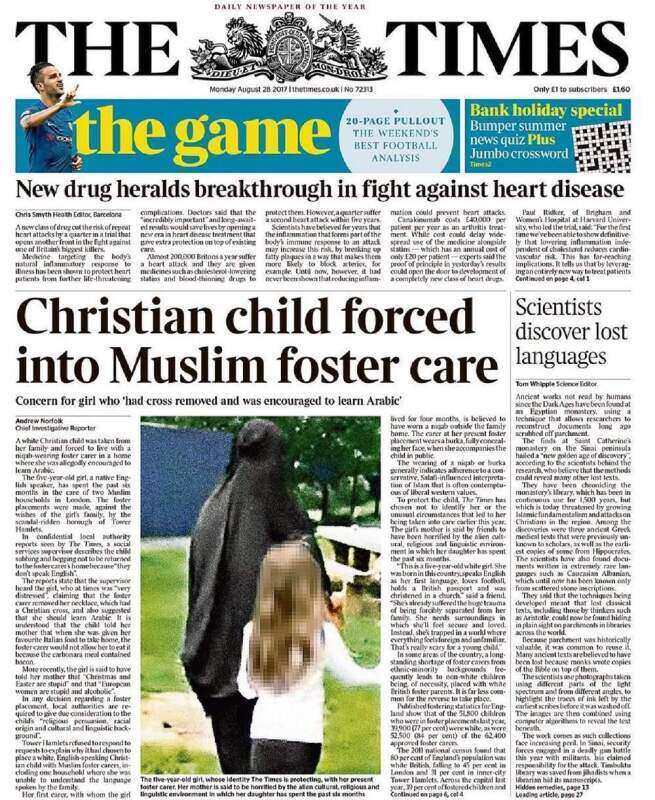
Sarah Everard case
Compare Sarah Everard this month with that of the killing of Bibaa Henry and Nicole Smallman last year. In both cases these were young women who went missing while in London parks and were later found dead, apparently killed by strangers.
The hunt for Sarah made page leads even before a policeman became a suspect, which certainly took the story to a whole new level.
The disappearance of the black sisters on a birthday celebration went unreported until their bodies were found – and even then, their deaths were pushed back in the book. There were no opinion pieces in every paper about women’s right to walk safely in the streets and the #notallmen pushback.
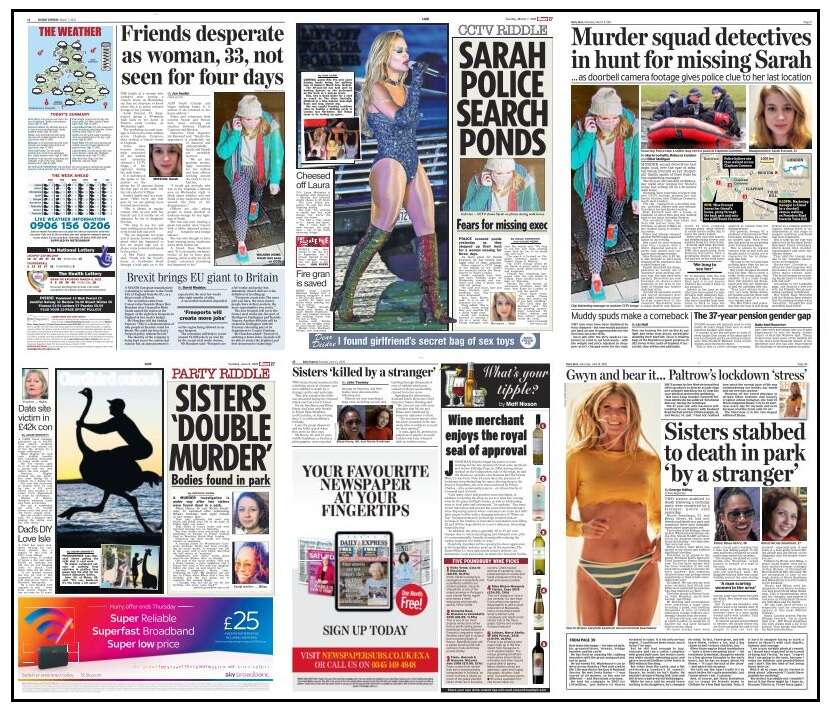
Compare the coverage of Sarah Everard with that of Bibaa Henry and Nicole Smallman, who all went missing while in London parks and were later found dead
When Islamic terrorists strike at Westerners, the focus is first on the victims, their backgrounds, their families’ despair, and then on the “maniac” killers.
When white terrorists strike at Muslims, whether in Finsbury Park or in Christchurch, New Zealand, scant attention is paid to the dead as papers try to work out what turned “an angelic child” into a monster.
The explanation is the key element – as with the Telegraph heading after the Finsbury Park attack in 2017 in which a white man drove a van into a crowd outside a mosque: “Terror suspect ‘turned against’ Muslims after London attack”.
White British killers – including the man who murdered Jo Cox – are rarely described as terrorists. But they are frequently “lone wolves” – which presumably absolves “white community leaders” from a duty to come together to stop them.
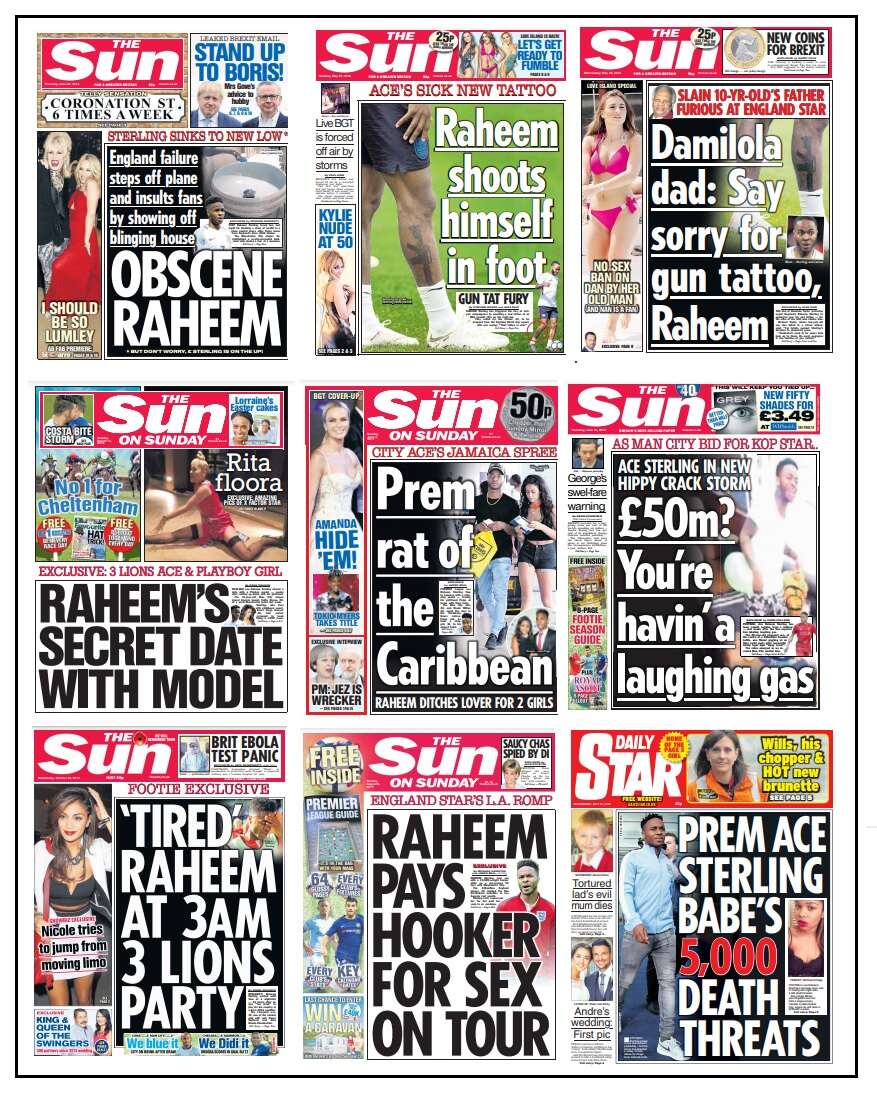
Footballer Raheem Sterling has suffered multiple attacks
Raheem Sterling (who could have a whole chapter devoted to him in any book on prurience and prejudice) skewered Mail Online for the different treatment of two footballers – one black, one white – who each bought their mum a house with their new-found wealth.
Meghan Markle
Buzzfeed neatly documented how the Duchess of Cambridge’s avocados, lilies of the valley and bump caressing were all endearing and charming, while the Duchess of Sussex’s were cruel, toxic and self-obsessed.
Many journalists have no time for Meghan.
They argue that the coverage goes with the territory, that she wants publicity only on her own terms (don’t we all?) and that Royal Family incomers have always had to put up with negative headlines – from the “Duchess of Pork” to “Waity Katy”. Which is a bit like Matt Hancock telling nurses that they should be grateful for a 1% pay rise because others have got nothing. “We’re horrid to everyone and even more so to other people” isn’t a great defence. And it’s hard to find evidence for one claim that Kate had it “a million times worse”.
It’s also hard to prove that coverage, while cruel, was racist. Three examples stick out: Rachel Johnson’s column about her “dreadlocked mother” and “exotic blood”, the Star’s “Harry to marry gangster royalty?” and the Mail Online’s “Straight outta Compton”, highlighting a drugs-and-gangs neighbourhood near her mother’s Los Angeles home. The Mail may not have suggested that Meghan was part of some black gangster culture – as the Star did – but nor does it make clear the affluence of the Windsor Hills area where she was brought up. “Improving” doesn’t quite cut it.
It is possible to argue that the stories just paint a picture of her background, as the papers did – and still do – with the Middletons. We’re always interested in where anyone with royal connections comes from, and there is always more appetite for the unsavoury, a more enthusiastic search for skeletons than apple pie. But when you look at those Buzzfeed comparisons, it’s natural to wonder – like Mrs Merton asking Debbie Magee what first attracted her to the millionaire Paul Daniels – what it was that made Meghan so bad where Kate was so good.
The Mail on Sunday claimed a couple of weeks ago that it couldn’t have been racist because it had “welcomed Meghan with open arms”. It had. The reception when she first appeared on the scene was almost universally warm. But it swiftly cooled and for most of the time she spent in Britain, Meghan was subjected to a mix of barbed attacks and “helpful” advice over her many perceived faux pas, from how to behave at Wimbledon to her husband’s wardrobe.
Meghan comes from a different culture – in that she is American, not in that she is mixed race – and made her own fortune through forging her own career. She was never going to fit into the English rose stereotype of a beautiful princess who has babies, cuts ribbons and keeps her mouth shut.
She was “a breath of fresh air” who was bound to put a foot wrong occasionally. But did she deserve such opprobrium? Some questions, such as the use of public money, were obviously reasonable, but innocuous actions were portrayed in a bad light, mistakes pounced upon rather than understood. Fleet Street is unforgiving of those who refuse to play by its rules – and there’s no doubt she poked a hornet’s nest by daring to sue (and win).
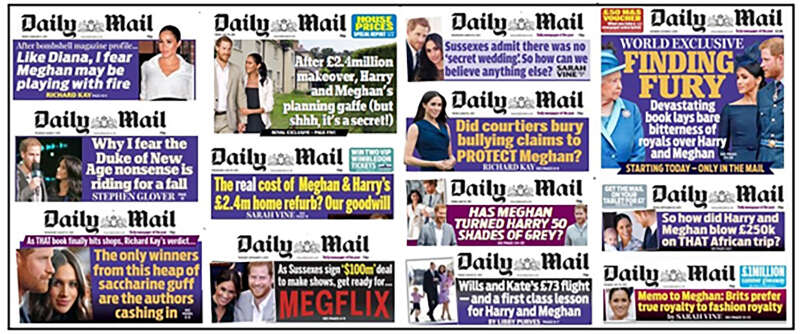
It is equally hard to find evidence that coverage of Meghan has been racist
Nor is there any doubt that the whole Megxit fallout, from the metaphorical resignation letter last year to the Oprah interview, is a genuine news story
Returning to the wider question of bigotry, Ian Murray blundered in his response to the Oprah show because he comes from the “defend the press at all costs” school of thought; the same school that doubles down when asked “couldn’t you be a little kinder?”, insisting: “We hold the powerful to account and any challenge to the way we behave is a direct assault on democracy itself” – as though being even slightly less horrid to wretched boat people or glamorous celebrities is the first step to totalitarianism.
Counting non-white faces on front pages
Everyone makes errors of judgment or taste. But newspapers behave as if they have some divine power of perfection. “We answer to our readers. We have to stand for election every day,” are the editors’ old arguments.
Unsurprisingly, former Daily Mail editor Paul Dacre used his valedictory address to defend his “no prisoners taken” approach to journalism, arguing that it was the press’s job to stand up for their readers, and mocking those who inhabited metropolitan “echo chambers”.
But what is the Mail – or any paper – and its loyal readers but an echo chamber? His paper spoke for the suburban middle class, not for the poor of Hartlepool or the black communities in Bristol, and certainly not for the 48% of the UK who voted ‘no’ in the 2016 Brexit referendum.
After his departure the Mail softened its stance on Europe and changed its tone more generally. But my analysis suggests it still has work to do when it comes to reflecting the diverse nature of British society.
Last year there were 807 white faces on the paper’s front page against 80 non-white, of which 40 belonged to Meghan.
Of those non-white faces, ten were related to crime or terrorism, nine were eye-candy celebs and six cabinet ministers (three apiece of Priti Patel and Rishi Sunak). Nicola Adams was there twice through Strictly, Kobe Bryant and his daughter were there for being killed in a helicopter crash, and a billionaire prince also made the front for dying at 38.
Two were Covid victims and two were Chinese women in masks. Naomi Campbell and Martin Bashir were there to be denounced and Stephen Lawrence is their cause célèbre. Which left two black girls going back to school and Patrick Hutchinson, the personal trainer who rescued a far-right protester at the BLM demo.
There was no space for even a postage stamp of history-making Kamala Harris. No Marcus Rashford. No Lewis Hamilton winning his seventh F1 world title and being named Sports Personality of the Year. There wasn’t even a dark face among the 13 uniformed carers celebrating the Mail Force cavalry bringing PPE to a Rochdale home.
The Daily Mail is far from unique in this imbalance.
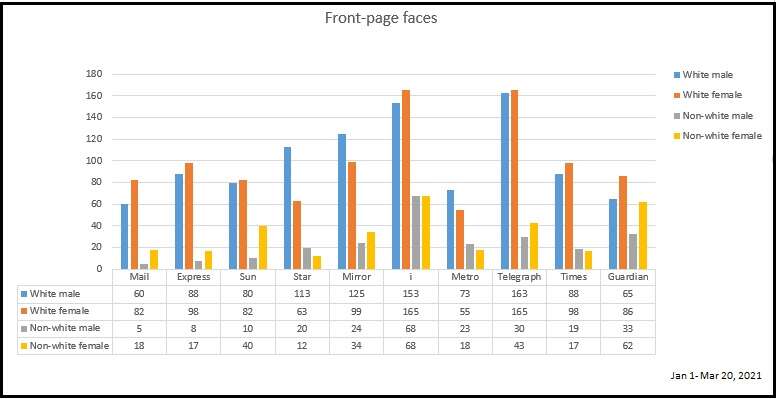
From the beginning of this year to last Saturday (March 20) just over 2,500 faces appeared on our national daily front pages. Three-quarters of them were white – and that proportion was kept down by the Guardian, where 39% of the faces were non-white.
Elsewhere, Meghan obviously accounted for a lot, and Premiership footballers in the puffs helped to make the figures more respectable, but generic happy family pictures, whether throwing snowballs or promoting cheap holidays, were almost invariably all-white and usually blonde.
As the Covid vaccine success story has dominated the front pages this year, the illustration of choice has been a white nurse wielding a syringe or the Prime Minister. He appeared on the front pages 101 times; Nadhim Zahawi, the minister supposedly responsible for the roll-out, not once. People of colour, who make up a big proportion both of NHS workers and of Covid victims, could be counted on the fingers of one hand.
When it came to the main photograph, 106 of 476 pictures in the seven papers that usually have a dominant image featured a non-white face – 50 of them Meghan. Of the rest, 21 were in the Guardian and 12 in the Mirror. That left 23 in the Times, Telegraph, Mail, Express and Sun put together, of which nine were Rishi Sunak.
There were 113 different named white people in those five papers, from Boris Johnson (who appeared 41 times) to Joan Collins, against nine people of colour: Meghan, Sunak, Tiger Woods, Halle Berry, Myleene Klass, Oprah Winfrey, Samira Ahmed, Shamima Begum and Benjamin Mendy. No generic scene included anyone who wasn’t white, although the Mail and Times both included non-white faces in composite pictures.
So we don’t see people of colour in our newsrooms and we don’t see them on our front pages (the disabled are even more invisible, but don’t get me started on that).
When you work alongside colleagues with a different background – be it educational, cultural or religious – your own outlook is broadened. People are people, whatever their colour, faith or sexuality. Some are affable and some a pain in the neck, and it’s not racist to dislike an individual because of their personal behaviour.
At the same time, you become more aware of what their lives involve; you are affronted on their behalf when they or their faith are subjected to generalisations, unfair allegations and abuse. As a journalist, you might just think twice about writing something that would be offensive to those around you – or at least check that basic assumptions are correct.
If there are no Muslims or gays or immigrants in the office, no black or brown faces, you are less likely to see the world from their perspective, less likely to care about them, and more likely to fall back on lazy, damaging stereotypes.
As Mills said in her resignation statement on Friday, if those making the decisions and writing the stories are not representative of the broader population, the press becomes not a true reflection of society, but a distorting lens.
We need to go to Specsavers.
Email pged@pressgazette.co.uk to point out mistakes, provide story tips or send in a letter for publication on our "Letters Page" blog
